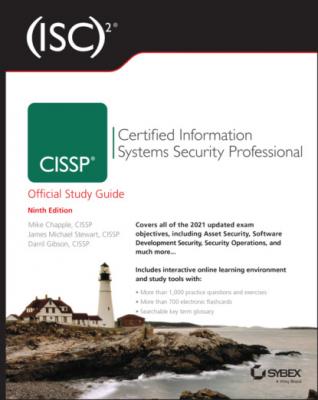(ISC)2 CISSP Certified Information Systems Security Professional Official Study Guide. Mike Chapple
Чтение книги онлайн.
Читать онлайн книгу (ISC)2 CISSP Certified Information Systems Security Professional Official Study Guide - Mike Chapple страница 97
 affecting the privacy and security of information, organizations must be aware of the laws passed by states, provinces, and other jurisdictions where they do business. As with the data breach notification laws discussed earlier in this chapter, states often lead the way in creating privacy regulations that spread across the country and may eventually serve as the model for federal law.
affecting the privacy and security of information, organizations must be aware of the laws passed by states, provinces, and other jurisdictions where they do business. As with the data breach notification laws discussed earlier in this chapter, states often lead the way in creating privacy regulations that spread across the country and may eventually serve as the model for federal law.
The California Consumer Privacy Act (CCPA) is an excellent example of this principle in action. California passed this sweeping privacy law in 2018, modeling it after the European Union's GDPR. Provisions of the law went into effect in 2020, providing consumers with the following:
The right to know what information businesses are collecting about them and how the organization uses and shares that information
The right to be forgotten, allowing consumers to request that the organization delete their personal information, in some circumstances
The right to opt out of the sale of their personal information
The right to exercise their privacy rights without fear of discrimination or retaliation for their use
Compliance
Over the past decade, the regulatory environment governing information security has grown increasingly complex. Organizations may find themselves subject to a wide variety of laws (many of which were outlined earlier in this chapter) and regulations imposed by regulatory agencies or contractual obligations.
Payment Card Industry Data Security Standard
The Payment Card Industry Data Security Standard (PCI DSS) is an excellent example of a compliance requirement that is not dictated by law but by contractual obligation. PCI DSS governs the security of credit card information and is enforced through the terms of a merchant agreement between a business that accepts credit cards and the bank that processes the business's transactions.
PCI DSS has 12 main requirements.
Install and maintain a firewall configuration to protect cardholder data.
Do not use vendor-supplied defaults for system passwords and other security parameters.
Protect stored cardholder data.
Encrypt transmission of cardholder data across open, public networks.
Protect all systems against malware and regularly update antivirus software or programs.
Develop and maintain secure systems and applications.
Restrict access to cardholder data by business need-to-know.
Identify and authenticate access to system components.
Restrict physical access to cardholder data.
Track and monitor all access to network resources and cardholder data.
Regularly test security systems and processes.
Maintain a policy that addresses information security for all personnel.
Each of these requirements is spelled out in detail in the full PCI DSS standard, which can be found at pcisecuritystandards.org. Organizations subject to PCI DSS may be required to conduct annual compliance assessments, depending on the number of transactions they process and their history of cybersecurity breaches.
Dealing with the many overlapping, and sometimes contradictory, compliance requirements facing an organization requires careful planning. Many organizations employ full-time IT compliance staff responsible for tracking the regulatory environment, monitoring controls to ensure ongoing compliance, facilitating compliance audits, and meeting the organization's compliance reporting obligations.
Organizations may be subject to compliance audits, either by their standard internal and external auditors or by regulators or their agents. For example, an organization's financial auditors may conduct an IT controls audit designed to ensure that the information security controls for an organization's financial systems are sufficient to ensure compliance with the Sarbanes–Oxley Act (SOX). Some regulations, such as PCI DSS, may require the organization to retain approved independent auditors to verify controls and provide a report directly to regulators.
In addition to formal audits, organizations often must report regulatory compliance to a number of internal and external stakeholders. For example, an organization's board of directors (or, more commonly, that board's audit committee) may require periodic reporting on compliance obligations and status. Similarly, PCI DSS requires organizations that are not compelled to conduct a formal third-party audit to complete and submit a self-assessment report outlining their compliance status.
Contracting and Procurement
The increased use of cloud services and other external vendors to store, process, and transmit sensitive information leads organizations to a new focus on implementing security reviews and controls in their contracting and procurement processes. Security professionals should conduct reviews of the security controls put in place by vendors, both during the initial vendor selection and evaluation process and as part of ongoing vendor governance reviews.
These are some questions to cover during these vendor governance reviews:
What types of sensitive information are stored, processed, or transmitted by the vendor?
What controls are in place to protect the organization's information?
How is your organization's information segregated from that of other clients?
If encryption is relied on as a security control, what encryption algorithms and key lengths are used? How is key management handled?
What types of security audits does the vendor perform, and what access does the client have to those audits?
Does the vendor rely on any other third parties to store, process, or transmit data? How do the provisions of the contract related to security extend to those third parties?
Where will data storage, processing, and transmission take place? If outside the home country of the client and/or vendor, what implications does that have?
What is the vendor's incident response